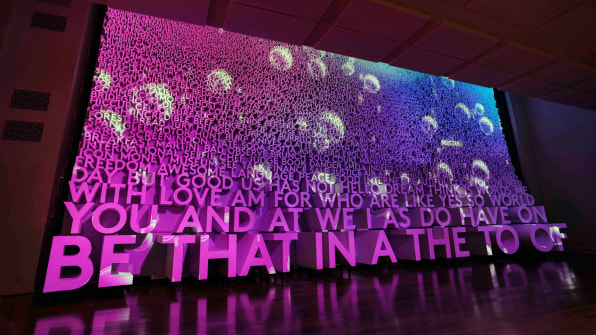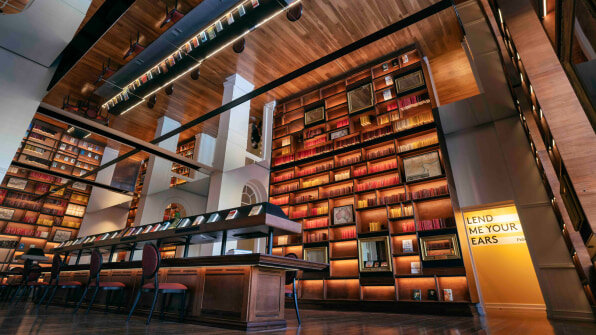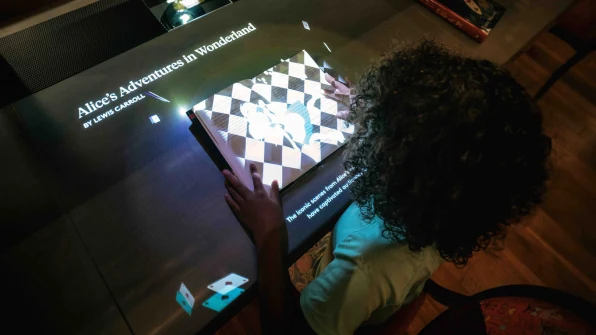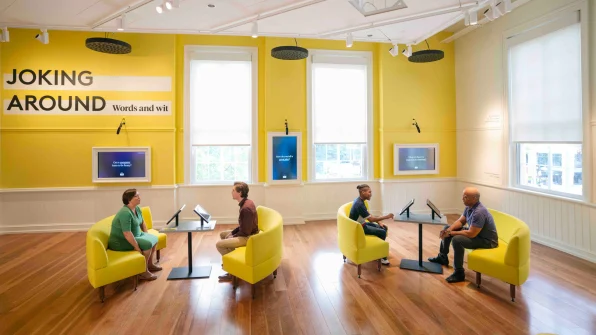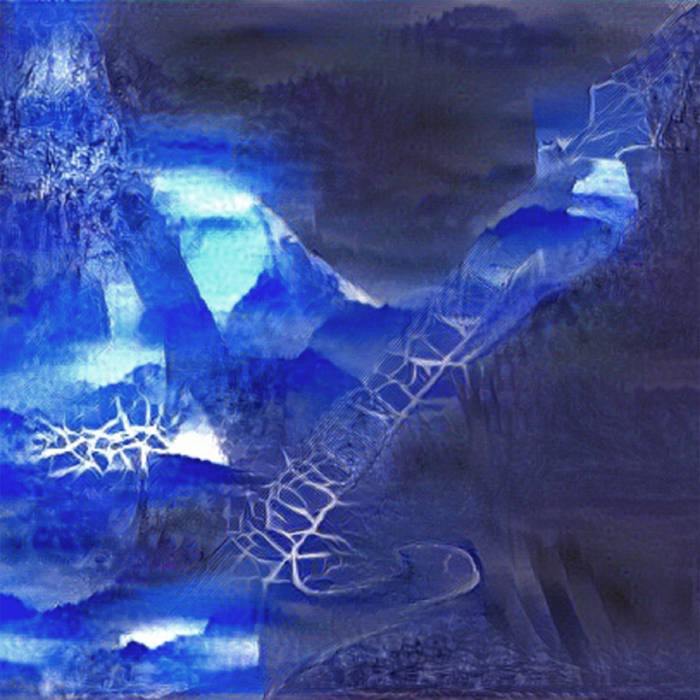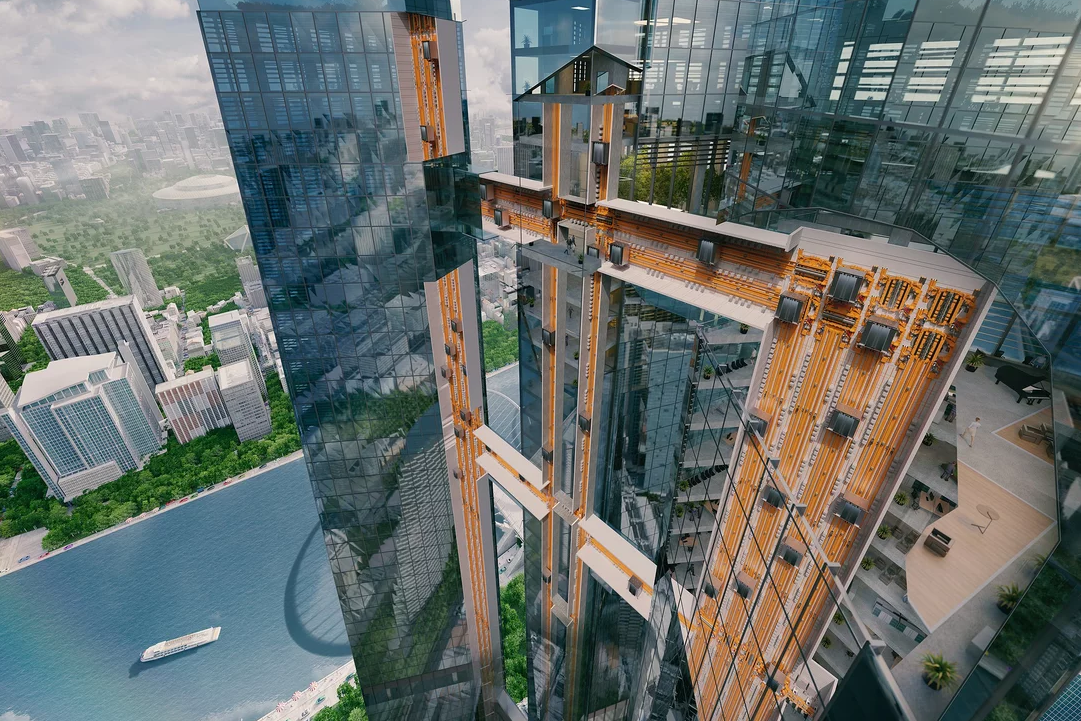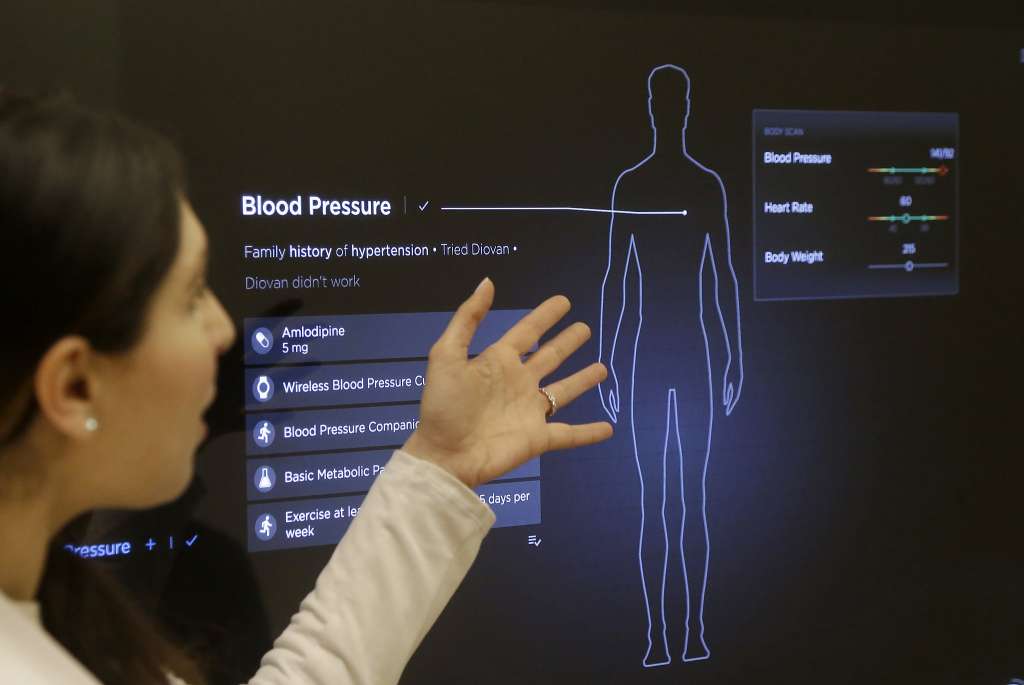Noisy Jelly: Making sound tactile for kids of all ages
Saw this product 8 years or so and am happy to finally get it into the blog. More good stuff to come.
“French design students Raphaël Pluvinage and Marianne Cauvard have created the ultimate chemistry kit that allows kids (or the Devour staff) to cook up their own musical jellies in just 10 minutes. Fight the urge not to snack on your science.” –
At this awesome new museum, the exhibits respond to the sound of your voice
“Planet Word didn’t want to model a library, but the museum does include one. The space is designed to look traditional, with the wooden walls and shared reading tables you might imagine. The difference here is that, when you pull one of 100 books off the shelf and lay it down to read, that book comes to life with graphics that literally spill off the page while a narrator discusses the work.”
“Local Projects created the opposite of a place you go to read. Planet Word is a place you go to talk. This is the world’s first voice recognition powered museum, says Jake Barton, founder of Local Projects. It’s a museum where we want to put people into an active state.”
concept of the finite and its ecosystemic realities
In a world with limited resources, can we find ways to salvage what's disappearing? Can we innovate our way out of a finite landscape? This hour, TED speakers explore ideas about living with less.
Great podcast on the concept of the finite and its ecosystemic realities. Particularly interesting is ethnobotanist Mark Plotkin and the idea that understanding of the finite in indigenous peoples:
“One of the things that I see in working with and studying indigenous cultures is the concept of the finite and the concept of gratitude. Indians spend a lot of time thanking the gods of the forest, thanking the animals of the forest, not taking more than they need.”
“In a world with limited resources, can we find ways to salvage what's disappearing? Can we innovate our way out of a finite landscape? This hour, TED speakers explore ideas about living with less.”
S-Curves and Technologies Will Shape The Future
“As the curve matureD, the question became less about the technology itself and more about what could be built on top of it.”
“As the curve matured, the question became less about the technology itself and more about what could be built on top of it.”
S-CURVE
“As the curve matured, the question became less about the technology itself and more about what could be built on top of it.”
“ Today’s S curve is one of the mobile internet, while the previous was the PC internet. In each case, as the curve matured, the question became less about the technology itself and more about what could be built on top of it. That’s where we are with the mobile internet, with things like ride-sharing, Instagram, Instacart, and other things we can do with our phones today.
The thing is, though, when we get to that point in the curve, people always start to say the platform is dead, and “What have you done for me lately,” Evans argues.
And these predictable evolutions and reactions belie the fact, he tells Fast Company, that “these things are not overnight revolutions. Yes, the iPhone launches and people can look at it and say this is amazing, but it has taken 10 years to get to the point that the majority of the population has got something like that….Most people think that you’ll have a fully autonomous…car in a 5-to-10-year view, but there’s a long time between the first such car being sold, and all cars that are sold being autonomous, and then a long time from all that to all cars on the road being autonomous.” ”
Top 5 UI Trends for 2018
According to Emily Stevens at Usability Geek, Top 5 UI Trends for 2018 are those, “that will captivate the user, whisk them away on an interactive adventure.”
1. Full-Screen Video
What was once a huge no-go is fast becoming the hottest thing in UI. Fullscreen video is taking over – quite literally. For many designers, this will come as no surprise. We have long been embracing the full-size image, so it was only a matter of time.
However, what is the obsession with immersive video? How does the user really feel about it?
More and more, video is championed as the ultimate brand storyteller. Indeed, nothing is more engaging than a larger-than-life HD film. For brands, this is a highly effective medium for getting their message across.
However, this is nothing new. What has changed, perhaps, is the user’s attitude. Back in the day, a full-screen video would have been way too intrusive – especially with pesky audio thrown into the mix. However, thanks to the rise of augmented/virtual reality, today’s end user is much more open to a fully immersive experience.
For UI design, this means plenty more freedom. 2018 will see high-definition, cinema-worthy video taking over our screens in a big way, à la Scotch & Soda.
2. Going Off the Grid
In 2018, we are saying goodbye to the grid. Ok, not quite – but we are bending it a lot to make our own rules.
One of the most significant trends next year will be borderless design; doing away with chunky borders in favour of fluid storytelling.
Many will say we have the iPhone X to thank for this trend. Indeed, the website is a stunning example of sleek, borderless design in action – much like the phone itself. However, infinity screens and low-bezel smartphoneshave been a recurring theme throughout 2017, so it is not hard to see why borderless design is on the up.
Traditionally, designers have relied on grid-based systems to create consistent, logical blueprints. However, our newfound penchant for “edgeless” screens gives rise to a whole new way of thinking. Throughout 2018, UI designers will dare to venture further and further beyond the grid – paying less heed to rigid lines and instead of trying their hand at more fluid designs.
Indeed, outstanding UI is all about creating a seamless flow for the user, and borderless design will take this to new heights.
3. Supersize Typography
Video is not the only thing going large in 2018. Typography is getting unmistakably bigger, with UI designers genuinely embracing the oversized headline.
Like everything in UI, this larger-than-life trend is all about usability. Text is there to be read, after all – and the bigger it is, the sooner the user sees it. That means less time searching, more time reading; a victory for UI.
Surely this is obvious, so why is giant text suddenly a thing?
This is a carry-over from the flat design trend. Flat design focuses on minimal, simplistic typography, and, in the absence of stylistic variety, increasing the size of the text is another way to grab the user’s attention. While flat design is not such a hot topic for 2018, big text will continue to reign supreme.
Inevitably, the arrival of new trends sees old ones taking a backseat. With the rise of supersize text, colour contrast is no longer so important. So, throughout 2018, we can expect to see less colour-play and more experimentation with text size instead.
4. Vibrant Colors
We have already mentioned that flat design seems to be fizzling out – or evolving, at least. Forget muted tones and understated palettes; in the world of UI, 2018 will be the year of colour. From hot pinks and neon greens to acid yellows, we can once again look forward to some seriously vibrant colour combos.
Not only that. We can also celebrate the return of gradient. Thanks to the likes of Spotify and Instagram, the gradient will be trending in a big way. More and more, we will see UI dabbling in two-tone – be it image overlays with gradients, duotone overlays or more subtle colour transitions.
The best thing about this trend? It is easy to make it your own. There is so much room to experiment, 2018 will no doubt ignite many sub-trends. Watch this space!
5. Long-form Content
Part-trend, part-challenge – whichever way you look at it, long-form content will dominate in 2018.
The advantage of long-form content is that the user does not need to switch through various screens; they get all the information they need simply by scrolling. This single fluid motion is much more user-friendly than, say, clicking through a menu or going through multiple redirects.
For mobile users especially, such functionality can make or break the experience.
Brands are also pretty keen on lengthy content since it is good for SEO.
So what is a UI designer to do with all that text? Moreover, whatever happened to the above-the-fold rule?
This is a conundrum that more and more designers will face in 2018. Long scrolls will be critical, but the rise of long-form content may call for more innovative solutions. How will UI tackle this? Only time will tell.
Wrap Up
So what will UI look like in 2018? On the whole, we can expect to see a shift towards more experimental designs. Any lingering shyness when it comes to video will all but vanish, and designers will seek out more and more ways to create a truly immersive user experience.”
Click to Brick: Even Microsoft entering the fray
Kate Hudson
Co-founder of an e-tail company Fabletics an + a strong voice behind opening the 24 brick-and-mortar stores
Collect data about customers’ choices in the stores to better understand and better serve all Fabletics shoppers – from those buying digitally to those browsing the displays.
The company has since opened 22 stores across America, with two more opening soon. To truly test their retail experiment, Fabletics selected mid-size and suburban markets like Torrance, California; Skokie, Illinois; and Bridgewater, New Jersey.
“Let’s say a shopper clicks on a shirt, looks at it on our website but doesn’t buy it. Why didn’t she buy it? Was it the price? Was it the color? Was the image bad? We don’t know. We were just kind of lost on that.”
Bot Rock
This album is part of a submission to NIPS 2017 Workshop for Machine Learning, Creativity and Design: "Generating Black Metal and Math Rock".
This album was generated with a recurrent neural network trained on raw audio from the album "Diotima" by Krallice. All titles were generated by a Markov chain. The album cover was created with neural style transfer.
http://dadabots.com/
Album cover, bot-created.
Form and Function: That Content Really Ties the Room Together – Convergent AV
TAD Partner and Director of Content, Jeffrey Casserino says he’s seen four legitimate opportunities to design and deploy business-critical interactive content:
- BRANDING AND INTERACTIVE: : Traditional signage and promotional content is now interactive. In fact, according to Embed Signage, interactive signage increases advertising revenue by 1200%. Digital experience companies must align with the objectives of the client-side marketing departments.
- GUI’s : Graphical User Interfaces, on control panels like Crestron, AMX, or Uteology, are ubiquitous and tend to be system agnostic. However, if the UI is not easy to use, then the system doesn’t work. Customization of this human-machine interface point is seen to be on the rise.
- DATA VISUALIZATION: Data is crazy available now, and there are numerous firms that offer ways to aggregate, which defines the problem of consumption. Content designers are now being asked to create models that translates data from external sources into easily consumed visuals that are intuitive to the sight. The balance between art of visualization and the science of relevant data sets.
- MOBILE APP DEVELOPMENT: Events, facilities, wayfinding, marketing and branding, it’s now standard practice to leverage the supercomputers that we all have in our pockets. Mobile app development is now a service that many digital design firms are offering. TAD Associates, when designing experience centers or EBC’s, will often offer to package wayfinding and itinerary mobile apps to help its clients provide a full package of customer/ employee engagement tools.
GreenWave 3D Ocean Farm
GreenWave 3D Ocean Farm
The future of farming is growing oysters, mussels, clams and seaweed on ropes anchored to the ocean floor. So says Bren Smith, a commercial fisherman turned director of GreenWave, a Connecticut nonprofit doing just that. The concept isn’t as wild as it may seem. As land farming becomes increasingly problematic—it accounts for a growing portion of the planet’s greenhouse-gas emissions—and oceans get overfished, humans will need to develop alternative food sources. GreenWave’s crops offer compelling advantages: they’re protein-rich, self-sufficient (no fertilizer needed) and they even help combat climate change (by sequestering carbon as they grow). Of course, getting Westerners to center their diet on mollusks and seaweed is a stretch. Still, GreenWave sees potential: the group has helped fishermen establish 14 farms along the coast of New England since 2013, and now has plans to expand in California, the Pacific Northwest and Europe. —Julia Zorthian
Elevators That Move Beyond Up and Down
Thyssenkrupp MULTI
What if elevators could move sideways, instead of just up and down? It’s a question straight out of Charlie and the Chocolate Factory, and Germany-based Thyssenkrupp has a real-life answer: MULTI, a system of elevators that ditches old-school pulleys for the same magnetic levitation tech that enables high-speed trains. The elevator cars can travel in multiple directions and even pass each other within a shaft—features that could not only reduce wait times, but also fundamentally“change how buildings are constructed,”says Andreas Schierenbeck,CEO of Thyssenkrupp Elevator. (Think horizontal offshoots of straight, vertical towers.) Following a successful test this year, the first MULTI is set to debut in Berlin by 2021. —Julia Zorthian
FORWARD: CUSTOMIZING + RedefinING Preventive Care
In the U.S., patients tend to visit doctors only after they get sick. But what if both parties worked together to pre-empt medical issues as well? That’s the idea behind Forward, a new type of wellness clinic that works much like a high-end gym. For $149 a month, users get unlimited access to genetic screenings, blood testing, weight-loss planning, routine doctors’ visits and more all of which help Forward“look toward your future and look out for things that are longer term,”says Adrian Aoun, the founder and CEO, and a former Google executive. (Forward does offer reactive medicine too, including unlimited generic medications without co-pays.) Critics argue most Americans can’t afford the clinics, especially since they do not accept health insurance. But as a niche experiment, Forward appears to be working: the company, which is based in San Francisco, has reportedly raised $100 million in funding and recently opened a location in L.A.; it plans to expand to other cities in the future. —Alexandra Sifferlin
Hartmut Esslinger AWARDED THE 2017 WDO WORLD DESIGN MEDAL IN TORINO, ITALY
frog in the News: Founder Hartmut Esslinger Wins Multiple 2017 Design Awards
“From influential work with Steve Jobs and Apple to his continuing influence on the global design community, Hartmut Esslinger has made a lasting impact. Here’s a look at why there are so many reasons to celebrate frog's founder right now.
Often credited as the first designer to bring human-centered design to the world of complex hardware and software technology, Esslinger was the recipient of the 2017 Cooper Hewitt Lifetime Achievement Award presented this month. As part of National Design Week on October 19, we had the honor of celebrating Hartmut’s achievements alongside him and to once again be inspired and invigorated by his unfailing dedication and vision to advancing the human experience through design.
In a true honor for a truly global designer, Esslinger won the 2017 WDO World Design Medal from the World Design Organization. The honor showcases industrial designers who drive positive change in the world through design. The unanimous decision from the selection committee was based on his decades of experience in the field (which includes founding frog with his wife Patricia Roller in the Black Forest of Germany back in 1969), as well as his legacy of work teaching the design leaders of today and tomorrow.
As part of the Teen Design Fair, Esslinger and frog were on-hand with other winners of the National Design Awards to answer questions from aspiring young designers about possible career paths, the challenges designers face within teams and in the workplace, and what is most inspiring about design today. Throughout his career, Esslinger has taught design students in Germany, Austria, China and the US.”
From his influential work with Steve Jobs to his continuing influence on the global design community, Hartmut Esslinger has made a lasting impact. Here’s a look at why there are so many reasons to celebrate our founder right now.
“Rather than looking for markets to disrupt, we need to look for human endeavors that we can empower.”
The End of Moore's Law Will Change How We Need To Think About Innovation
A shift from disrupting markets to tackling grand challeneges
In 1965, Intel cofounder Gordon Moore published a remarkably prescient paperwhich predicted that computing power would double about every two years. For a half century, this process of doubling has proved to be so remarkably consistent that today it is commonly known as Moore's Law and has driven the digital revolution.
In fact, we've become so used to the idea that our technology gets more powerful and cheaper that we scarcely stop and think about how unprecedented it is. Certainly, we did not expect horses or plows -- or even steam engines, automobiles or airplanes -- to double their efficiency at a continuous rate.
Nevertheless, modern organizations have come to rely on continuous improvement to such an extent that people rarely think about what it means and, with Moore's law about to end, that's going to be a problem. In the decades to come, we're going to have to learn to live without the certainty of Moore's law and operate in a new era of innovation that will be profoundly different.
THE VON NEUMANN BOTTLENECK
Because of the power and consistency of Moore's Law, we've come to associate technological advancement with processor speeds. Yet that is only one dimension of performance and there are many things we can do to get our machines to do more at lower cost than just speeding them up.
A primary example of this is called the von Neumann bottleneck, named after the mathematical genius who is responsible for the way our computers store programs and data in one place and make calculations in another. In the 1940s, when this idea emerged, it was a major breakthrough, but today it's becoming somewhat of a problem.
The issue is that, because of Moore's Law, our chips run so fast that in the time it takes information to travel back and forth between chips -- at the speed of light no less -- we lose a lot of valuable computing time. Ironically, as chip speeds continue to improve, the problem will only get worse.
The solution is simple in concept but elusive in practice. Just as we integrated transistors onto a single silicon wafer to create modern day chips, we can integrate different chips with a method called 3D stacking. If we can make this work, we can increase performance for a few more generations.
Optimized Computing
Today we use our computers for a variety of tasks. We write documents, watch videos, prepare analysis, play games and do many other things all on the same device using the same chip architecture. We are able to do this because the chips our computers use are designed as a general purpose technology.
That makes computers convenient and useful, but is terribly inefficient for computationally intensive tasks. There have long been technologies, such as ASICand FPGA, that are designed for more specific tasks and, more recently, GPU's have become popular for graphics and artificial intelligence functions.
As artificial intelligence has risen to the fore, some firms, such as Google and Microsoft have begun designing chips that are specifically engineered to run their own deep learning tools. This greatly improves performance, but you need to make a lot of chips to make the economics work, so this is out of reach for most companies.
The truth is that all of these strategies are merely stopgaps. They will help us continue to advance over the next decade or so, but with Moore's Law ending, the real challenge is to come up with some fundamentally new ideas for computing.
Profoundly New Architectures
Over the last half century, Moore's Law has become synonymous with computing, but we made calculating machines long before the first microchip was invented. In the early 20th century, IBM first pioneered electromechanical tabulators, then came vacuum tubes and transistors before integrated circuits were invented in the late 1950s.
Today, there are two new architectures emerging that will be commercialized within the next five years. The first is quantum computers, which have the potential to be thousands, if not millions, of times more powerful than current technology. Both IBM and Google have built working prototypes and Intel, Microsoft and others have active development programs.
The second major approach is neuromorphic computing, or chips based on the design of the human brain. These excel at pattern recognition tasks that conventional chips have trouble with. They also are thousands of times more efficient than current technology and are scalable down to a single tiny core with just a few hundred "neurons" and up to enormous arrays with millions.
Yet both of these architectures have their drawbacks. Quantum computers need to be cooled down to close to absolute zero, which limits their use. Both require profoundly different logic than conventional computers and need new programming languages. The transition will not be seamless.
A New Era Of Innovation
For the past 20 or 30 years, innovation, especially in the digital space, has been fairly straightforward. We could rely on technology to improve at a foreseeable pace and that allowed us to predict, with a high degree of certainty, what would be possible in the years to come.
That led most innovation efforts to be focused on applications, with a heavy emphasis on the end user. Startups that were able to design an experience, test it, adapt and iterate quickly could outperform big firms that had far more resources and technological sophistication. That made agility a defining competitive attribute.
In the years to come the pendulum is likely to swing from applications back to the fundamental technologies that make them possible. Rather than being able to rely on trusty old paradigms, we'll largely be operating in the realm of the unknown. In many ways, we'll be starting over again and innovation will look more like it did in the 1950's and 1960's
Computing is just one area reaching its theoretical limits. We also need next generation batteries to power our devices, electric cars and the grid. At the same time, new technologies, such as genomics, nanotechnology and robotics are becoming ascendant and even the scientific method is being called into question.
So we're now entering a new era of innovation and the organizations who will most effectively compete will not be the ones with a capacity to disrupt, but those that are willing to tackle grand challenges and probe new horizons.
Look elsewhere – Signal v. Noise
Look elsewhere
Don’t stare at your industry. Look in the opposite direction.
When I’m designing software, I try to draw from a variety of influences, including:
NATURE
Want to find colors and patterns and shapes that go well together? Stop looking at catalogs of print designs or stock photos — look at trees and flowers and insects and animals. Their designs have been perfected over millions of years. They have beauty and utility figured out by now.
Watches
At their most basic, they all do the same thing — tell time with just three components: a minute hand, an hour hand, and markers on the dial. It turns out there are thousands of variations to accomplish this simple task, so don’t tell me there are only a few ways to display photos in your app.
CARS
I love looking at well-designed dashboards, instrument clusters, door handles, switches, and buttons. There’s so much to learn about what feels right and what falls flat. Sounds are telling as well — the engine, the snick of a manual shift, the click of the turn signal, the confident thud of a door that closes snug and tight. Those are all design features.
CHAIRS
A chair is such a basic device, but it can take thousands of forms. What does it feel like to sit in a chair that is nailed together, versus one that is glued or joined? What does a cotton-webbing seat feel like compared with wicker? Arms at different heights — or no arms at all?
The details may be different in software, but the feelings are the same. Other companies may prefer a serious museum look, and there are plenty of products that resemble museum pieces. But if you want something that’s comfortable and welcoming, Basecamp’s going to be more your speed. It has a “come on in and get cozy,” living room feel, not a cold, modern, “don’t touch it or you’ll mess stuff up” vibe.
So figure out what objects and places inspire you and immerse yourself in them. Pay attention to those details. Then, instead of imitating competitors, you just might find your voice.
How the blockchain is changing money and business | Don Tapscott
How the blockchain is changing money and business | Don Tapscott
- Protecting rights through immutable records
- Creating a true sharing economy
- Ending the remittance report off
- Enabling citizens to own and monetize their data and protect privacy
- Ensuring compensation for the creators of value
How the blockchain is changing money & business | Don Tapscott, TED
- Protecting rights through immutable records
- Creating a true sharing economy
- Ending the remittance report off
- Enabling citizens to own and monetize their data and protect privacy
- Ensuring compensation for the creators of value
Loving the 16 yr old “Sneaker Don”
Loving the 16 yr old “Sneaker Don”… and apparently so are DJ Khaled and Chris Brown. His 1+ Million in sales track with 2018 projected sports global shoe sales of 84.4 Billion. source: Transparency Market Research #entrepreneurship #disrupt #kids #growth #shoes #2018 #sportshoe #Sneakers #Kicks #Consumption
ELIA FRAMES™ “The world's most intuitive tactile reading system”
“The ELIA FRAMES™ font is designed for maximum tactile discrimination by people who have a visual impairment. It is so easy to learn that it can be studied and applied in as little as 2 hours. And because ELIA FRAMES is based on the standard Roman alphabet, it can be read visually by those with full sight (teachers, caregivers or co-workers).”
Flat UI leads reduces usability by 22%
“In experiment used to target findability tasks, more time and effort spent looking around the page are not good. These findings don't mean that users were more 'engaged' with the pages. Instead, they suggest that participants struggled to locate the element they wanted, or weren't confident when they first saw it."



